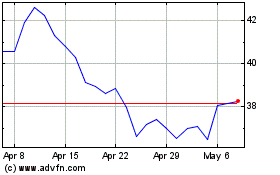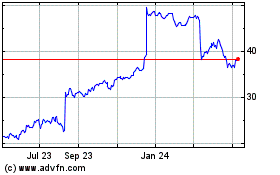By Bob Tita and Andrew Tangel
Some U.S. steel and aluminum makers are restarting idle mills
and ramping up capacity to make up for imports that face being
priced out of the market if President Donald Trump's proposed
import tariffs take hold.
United States Steel Corp. on Wednesday said it would fire up a
blast furnace in Granite City, Ill., and call back 500 workers.
Century Aluminum Co. said last week it will restart lines at a
smelter in Kentucky that have been curtailed since 2015, doubling
its workforce there to 600.
"Our Granite City Works facility and employees...have suffered
too long from the unending waves of unfairly traded steel products
that have flooded U.S. markets," U.S. Steel Chief Executive David
Burritt said. The company had idled the furnaces and laid off
hundreds of workers in 2015 as a flood of cheap imports pushed down
domestic prices.
U.S. Steel shares rose 3.8% Wednesday to $46.25, making for a
28% increase in the past 12 months.
American steel and aluminum makers could still lose out to
foreign competitors if they can't make enough metal to meet demand,
even at higher prices. Producers have struggled for years to
compete with foreign mills, particularly in China, that have ramped
up production at lower prices.
New tariffs on foreign steel and aluminum of 25% and 10%,
respectively, proposed by Mr. Trump last Thursday would give U.S.
producers the price advantage they have lobbied for in recent
years.
Critics say the tariffs will damage relationships with Canadian
and European allies, slow economic growth and harm American
metal-consuming industries. The president and his aides have said
the tariffs, including those already imposed on solar panels and
washing machines, are designed to give plants in the U.S. more
opportunities to expand production and employment. The White House
said Wednesday Mr. Trump would sign a proclamation by the "end of
the week."
Producers have "been given the keys to the city, and now they've
got to do something with it," said Curt Woodworth, a metals analyst
for Credit Suisse.
Annual U.S. raw steel production has hovered around 80 million
tons since the financial crisis, roughly half of the industry's
peak output in the 1970s. Aluminum production last year fell to
741,000 tons, less than a third of what was smelted here a decade
earlier. Aluminum imports in that time surged 60%.
Steel and aluminum prices have risen recently on higher domestic
demand and piecemeal tariffs against producers in other countries
including China, as well as Mr. Trump's support for broader
tariffs. Spot-market sheet-steel prices have risen more about 37%
since October to about $810 a ton, according to industry surveys.
The premium customers pay for aluminum deliveries has also
increased.
As a result, some companies were planning to expand U.S.
production even before Mr. Trump's new tariff plans. Alcoa Corp.
plans to reopen part of an idle smelter in southern Indiana this
spring. Luxembourg-based Tenaris SA opened a mill near Houston late
last year to make pipe for natural-gas and oil fracking wells.
Startup Big River Steel LLC, in Osceola, Ark., accelerated
production in 2017 at one of the largest sheet mills to be built in
the U.S. in years.
Steelmakers Nucor Corp. and Commercial Metals Co. are planning
to build small mills in Missouri and Oklahoma to supply the steel
reinforcing bar used in concrete for construction. Rebar and well
pipe are among the steel products that have faced some of the
heaviest competition recently against cheap imports from countries
including South Korea and Turkey.
Not all metalmakers are happy with the proposed tariffs.
California Steel Industries Inc. said the tariffs would hurt its
business importing steel slabs that it makes into pipes and sheets
used in construction.
Manufacturers that use steel and aluminum in their products,
including Caterpillar Inc. and Harley-Davidson Inc., have said the
tariffs could significantly increase their raw-material costs.
Construction-equipment maker Terex Corp. said this week it would
pass on higher steel costs to customers.
"We can't be the shock absorber for that significant increase,"
Chief Executive John Garrison said Tuesday.
Pittsburgh-based U.S. Steel said it would take about four months
to restart its Granite City furnace. It needs to replenish stocks
of coking coal and other ingredients used to melt ore into iron
inside the furnace and do other work to get it running again. The
furnace will add about 1.4 million tons of steel to the U.S. market
annually, analysts said, and generate up to $85 million in pretax
income this year for U.S. Steel. The plant has another idle furnace
that could make an additional 1.4 million tons of steel
annually.
A spokeswoman said the company hasn't reached a decision on
whether to restart the second furnace, as it monitors demand trends
in the market.
In Granite City, a town of some 30,000 just across the state
line from St. Louis, the local United Steelworkers office was
flooded with calls on Wednesday from former U.S. Steel workers
asking how they could get their jobs back. Many who didn't retire
when the plant was idled found jobs at nearby manufacturers or a
retail distribution center. Union officials said those jobs often
paid only half of what workers made at the steel mill.
"They're all ready to come back," said Dan Simmons, president of
United Steelworkers local 1899.
Granite City Mayor Ed Hagnauer said renewed hiring at what was
the town's biggest employer before the layoffs would benefit other
local businesses that have suffered since the plant scaled
back.
"We're an industrial town," he said. "This is a big bonus for
us. It really puts us on the right course."
--Allison Prang contributed to this article.
Write to Bob Tita at robert.tita@wsj.com and Andrew Tangel at
Andrew.Tangel@wsj.com
(END) Dow Jones Newswires
March 07, 2018 16:34 ET (21:34 GMT)
Copyright (c) 2018 Dow Jones & Company, Inc.
US Steel (NYSE:X)
Historical Stock Chart
From Mar 2024 to Apr 2024

US Steel (NYSE:X)
Historical Stock Chart
From Apr 2023 to Apr 2024
